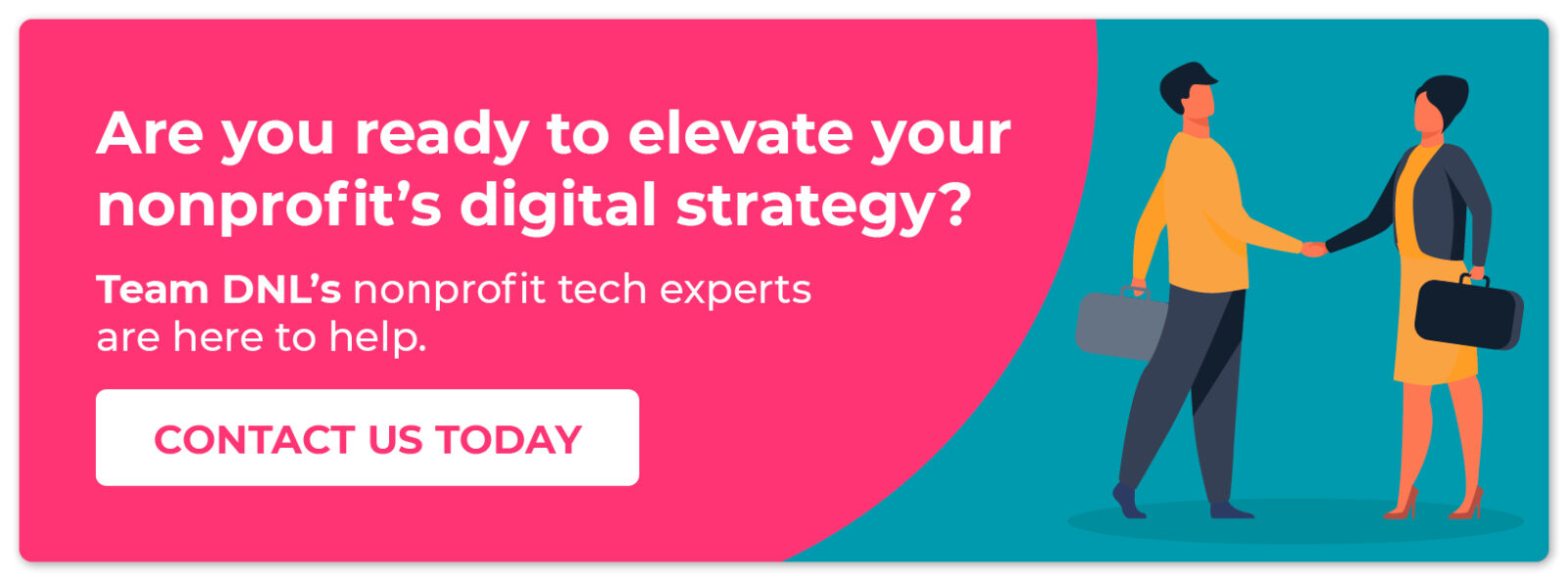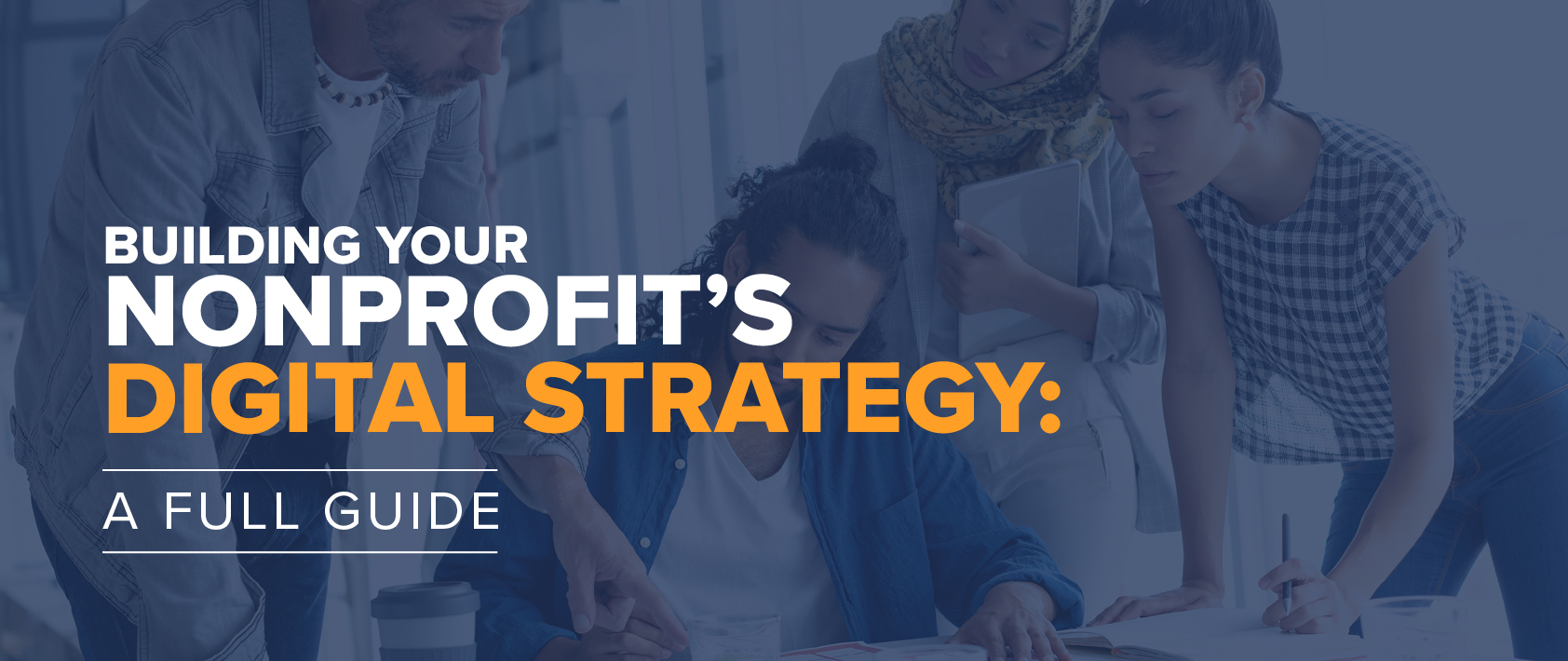In today’s nonprofit world, it’s impossible to succeed without having the right digital tools on your side. But in addition to having a robust technology stack, you must have a clear plan for using your tools effectively. In other words, your nonprofit needs an airtight digital strategy.
In this guide, we’ll walk you through everything you need to know to help you develop a digital strategy for your nonprofit that will help you market your mission, strengthen relationships with supporters, reach your fundraising goals, and deliver your programs and services successfully.
We’ll cover:
- What is a Nonprofit Digital Strategy?
- The Benefits of a Strong Digital Strategy
- Building a Digital Strategy for Your Nonprofit: 7 Steps
- Team DNL: Your Partner in Digital Strategy Success
If you’re ready to take your operations to the next level, it’s time to evaluate how your organization is using digital technology and implement sustainable improvements. Let’s dive into our guidance for doing just that!

What is a Nonprofit Digital Strategy?
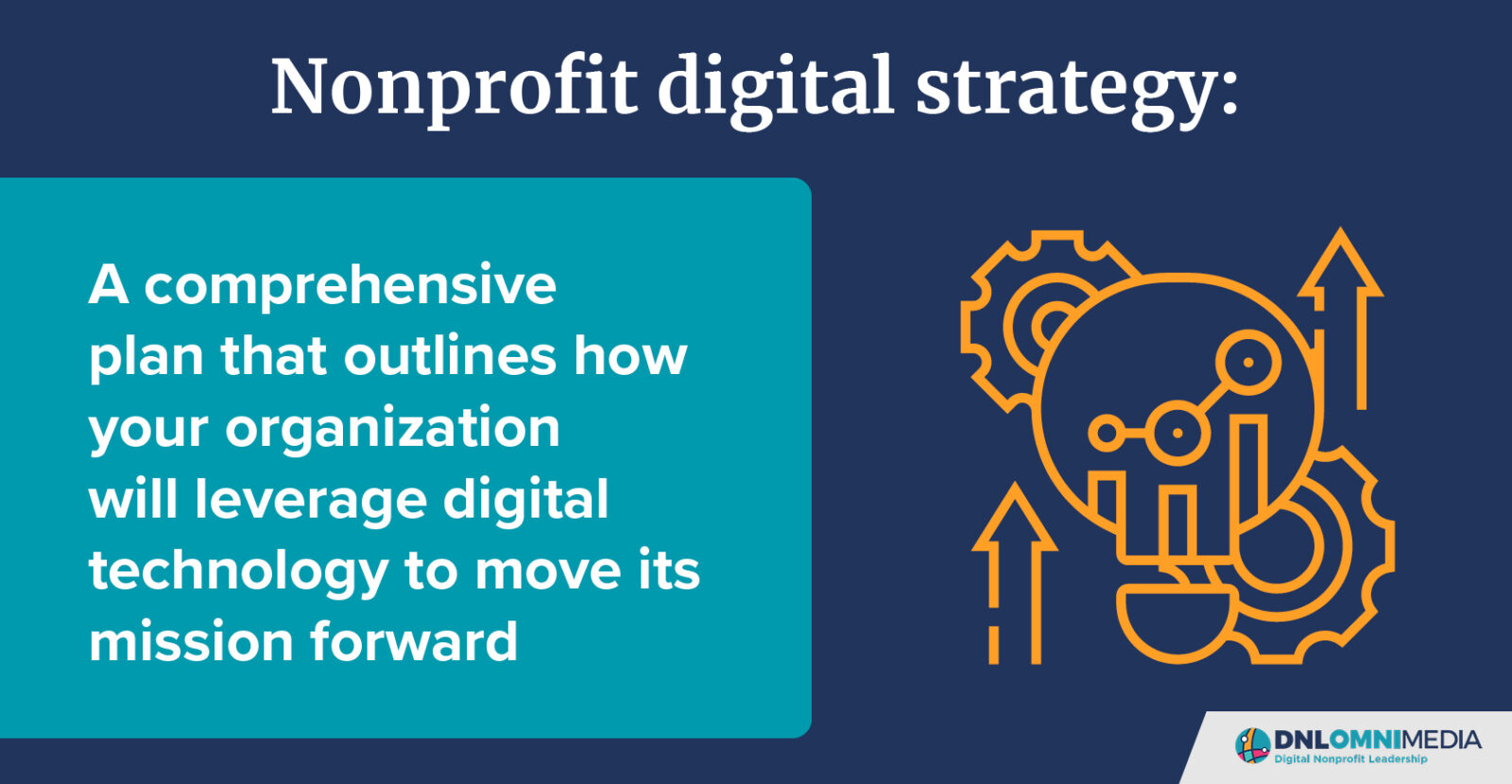
A nonprofit digital strategy is a comprehensive plan that outlines how your organization will leverage digital technology to move its mission forward.
Modern nonprofits use a wide range of technology tools in their operations, including but not limited to:
- Their websites
- Constituent relationship management (CRM) platforms
- Social media profiles
- Project management tools
- Collaboration and communication platforms
- Online giving software
- Email marketing software
- Financial management software
- Text messaging automation tools
- Volunteer management tools
- Data analytics and reporting tools
These tools all serve different purposes in a nonprofit’s operations. For example, communication platforms allow your internal team members to collaborate on projects like event management or fundraiser planning, your website can share educational information about your cause, and your CRM can gather and organize information about your supporters.
Your tools should also complement each other. This is why you need a clear, unified digital strategy—so you can make a plan for using your entire technology stack in intentional ways to support your organization’s everyday work as well as its larger goals and objectives.
The Benefits of a Strong Digital Strategy
Designing and implementing a careful digital strategy can provide your nonprofit and its community with a wealth of benefits. Here are a few examples:
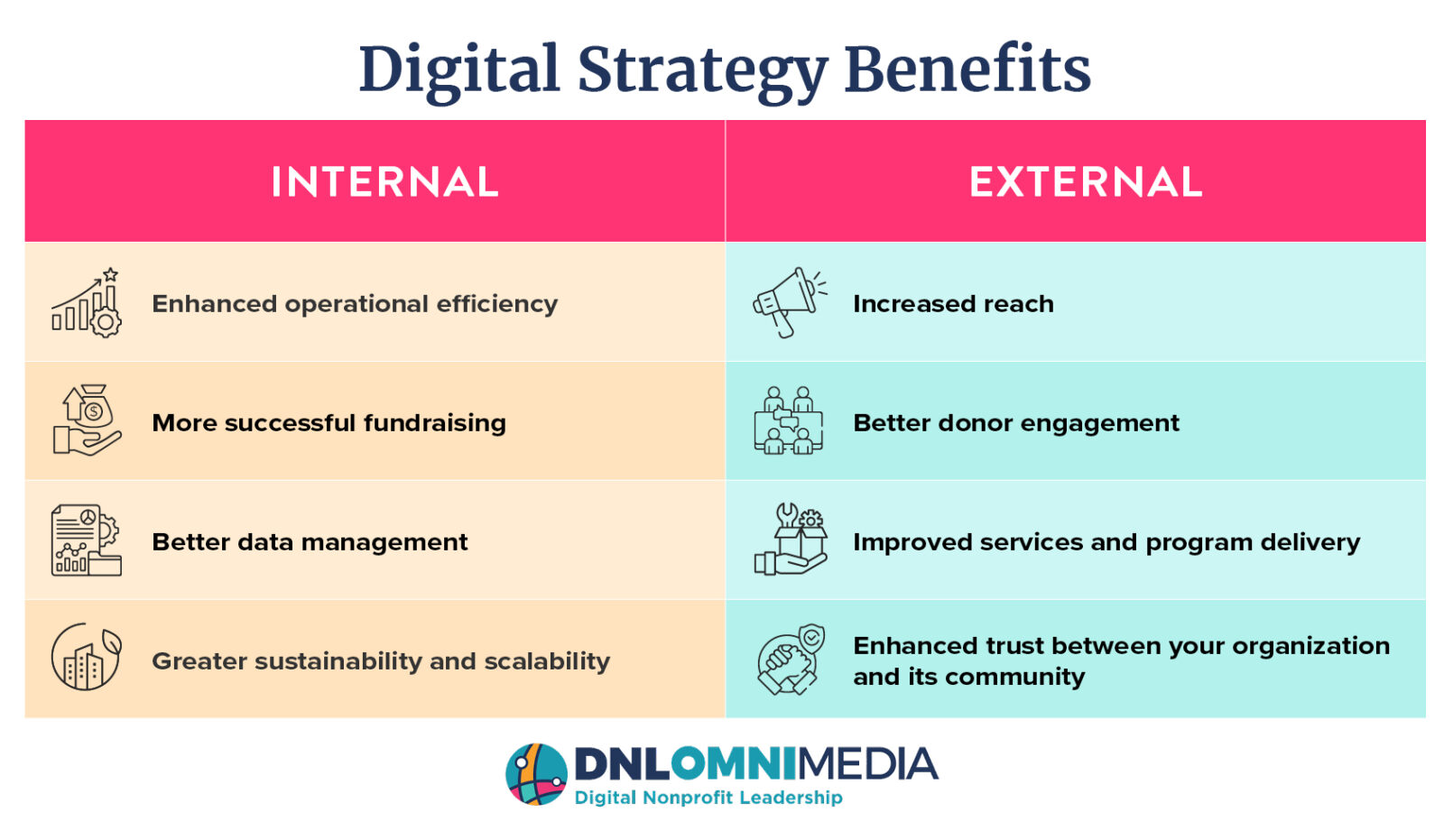
Internal Benefits
- Enhanced operational efficiency: As you choose the best tools for your nonprofit’s work, take advantage of integrations between those tools and become proficient in using all of the features those tools offer. As a result, you’ll communicate more easily, reduce the amount of time spent on administrative tasks, and automate repetitive tasks. This will free up your team’s time to focus on what matters most, like delivering high-quality services to your beneficiaries and strengthening relationships with your supporters.
- More successful fundraising: Using digital tools strategically makes it easier for your organization to reach its fundraising goals. You can use tools such as your CRM and social media management platforms to learn about your donors’ needs and preferences and then launch campaigns through easy-to-use online platforms, like peer-to-peer fundraising tools, crowdfunding pages, and more.
- Better data management: Data is key to successful nonprofit operations, and your organization likely has a lot of it. The right tools and strategy can help you collect, organize, and securely store your data. Then, you can more easily analyze this information and get accurate insights into different aspects of your organization, like donor behaviors or program outcomes. These insights can empower you to make informed, strategic decisions to keep your organization on course to accomplish its mission.
- Greater sustainability and scalability: As your organization grows over time, your technology stack and accompanying strategy will need to adapt to your changing needs. Having a clear digital strategy allows you to build your toolkit and use your tools in ways that keep growth in mind from the beginning, ensuring that you grow sustainably.
External Benefits
- Increased reach: Some of the most important tools in your technology stack and digital strategy are marketing tools. Social media profiles, email marketing platforms, texting tools, and more can all help your nonprofit reach its target audience in several digital and geographic locations, spreading the message of your cause and expanding your community of supporters.
- Better donor engagement: Engaging your donors and maintaining strong relationships with them is essential to ensuring support is continually flowing into your organization. Having the right technology on your side makes it easier to consistently connect with donors in ways that resonate with them, invite them to give, and celebrate their contributions.
- Improved services and program delivery: With the right tools and processes in place, you can manage your resources more effectively, personalize your services and programs to your beneficiaries’ needs, and make data-driven decisions to improve your offerings. This means you can serve more people in better ways, fulfilling your mission and making a bigger difference in your community.
- Enhanced trust between your organization and its community: The best digital strategies will help your organization prioritize cybersecurity and data privacy. This means that your organization can assure its supporters and beneficiaries that you do everything in your power to keep their information safe, which can help strengthen your relationships with them.
Building Your Nonprofit’s Digital Strategy: 7 Steps
Given the importance of a cohesive nonprofit digital strategy, let’s walk through how your nonprofit can create such a plan. The process of outlining your nonprofit’s digital strategy can be broken down into seven steps, as follows:
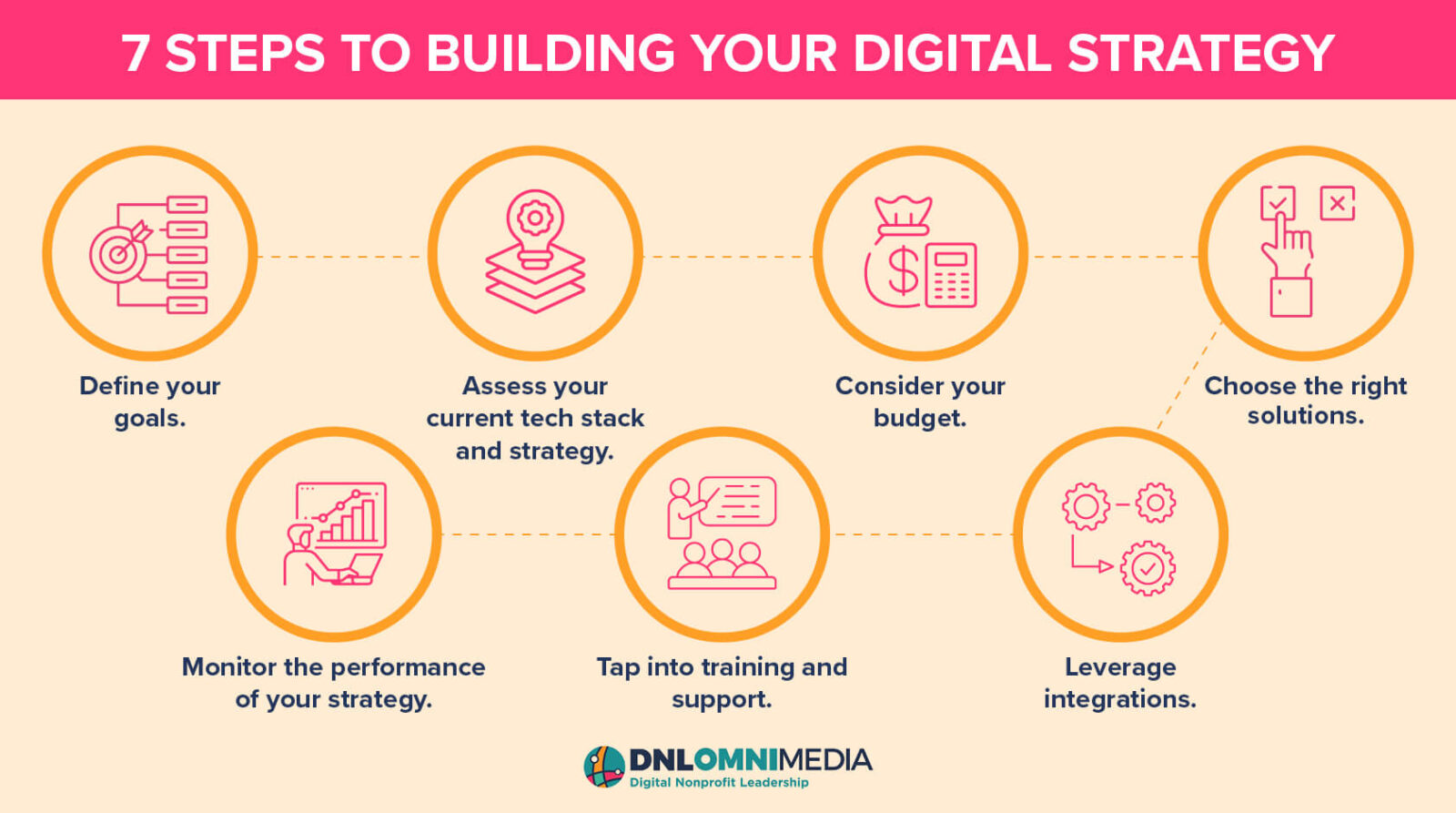
1. Define your goals.
Your team must employ a systematic approach when defining your digital strategy goals. You likely know what it is, generally, that you need to accomplish. Begin with writing out these goals in somewhat general terms, such as:
- Raise X amount of money.
- Increase public awareness of our mission
- Improve our team’s workflow efficiency
- Serve X more beneficiaries
- Grow our volunteer program
- Strengthen our digital security measures
Once you’ve written down your broad goals, it’s time to develop them into more concrete and actionable resolutions. Here are some tips for doing so:
- Analyze key metrics in your database. Develop a quantifiable target for your goal that’s ambitious but realistic. For example, if you’re seeking to boost online fundraising revenue, you might study data on past online campaigns and set a target of raising 10% more with your upcoming campaign.
- Speak with stakeholders. Collect feedback from your director, board, and high-level staff members who will be directly involved in executing your new digital strategy. Depending on the nature of your mission and prospective goals, you might also consider asking major donors, constituents, or community members for their thoughts.
- Review long-term priorities. Your digital strategy goals must align with your nonprofit’s broader mission-oriented goals, long-term programming plans, and concrete financial targets. Chances are, your long-term priorities will inherently influence the development of your digital strategy, but take the opportunity early on to ensure there are no contradicting priorities at play.
2. Assess your current technology stack and strategy.
With your concrete goals in mind, you’re ready to apply a critical eye to your current digital strategy. After all, even if you haven’t intentionally created a strategy before, you likely still have a toolbox full of digital tools and a variety of approaches to using those tools. Understanding this starting point is important for refining your digital strategy and ensuring that you’re making productive, positive changes.
Here are some tips for conducting a successful audit of your current strategy:
- List all of the technology solutions you’re currently using. Make a comprehensive list of all the tools at your team’s disposal, from your project management platforms to your marketing tools. You may discover you’re paying for subscriptions that you don’t want or need or that a tool you wanted to invest in is already available to your team.
- Identify the team members regularly using your software solutions and how they’re using those tools. Even if it seems obvious as to which teams are using certain tools, make sure you ask all team members to get a fuller view of how they’re using your technology stack. For instance, while your marketing team members may be the primary users of your graphic design tool, your major gift officers may use it from time to time to ensure donation appeal letters are branded to your organization.
- Identify gaps in your technology toolkit. Is there a tool missing from your technology stack that you wish you had access to? Is there an integration that would benefit your team but isn’t currently activated? Are your team members taking advantage of all of the features offered by your tools, or do they need more training to do so? Is there a tool that could be used cross-departmentally but isn’t currently? Find the gaps in your strategy that need filling.
- Gather insights from all departments to understand their specific technology needs and challenges. You may not be able to recognize what tools your team needs access to in their day-to-day work. Talk to department heads and other key players to get their thoughts on what tools would make their jobs better, as well as the training or support they need to make the most of them.
In addition to looking specifically at your technology stack and how team members are using it, take a close look at your current data management practices. Do you have a clear-cut system for collecting data, organizing it in a uniform way, and analyzing it? Additionally, are you performing regular database maintenance tasks to ensure that your data is accurate and useful? Since data plays such a key role in the use of so many nonprofit technology solutions, taking the time to evaluate your data management strategy will help you create a comprehensive digital strategy that takes full advantage of the information your organization has at its disposal.
3. Consider your budget.
As a nonprofit professional, you’re no stranger to working within a strict budget. As you prepare to make improvements to your organization’s digital strategy, make sure you review your budget and plan for what you want to invest in.
Here are a few things you will want to ensure you budget for:
- Working with a nonprofit technology consultant. A professional nonprofit technology consultant is an expert in nonprofit technology solutions and can guide you through the process of investing in and implementing new tools and refining your digital strategy. Many nonprofits choose to work with these professionals in order to get an expert third-party perspective on their plans and tap into training and support opportunities. Some technology consultants may even be able to build custom integrations and solutions for your organization. Jump ahead to learn about the consultants at DNL OmniMedia!
- Investing in new solutions. After auditing your current technology stack, you likely discovered gaps or needs that you can address by incorporating a new tool into your workflows. Ensure you’re prepared to invest in your chosen solutions at the appropriate level for your operations. (For instance, for some tools you may need to go beyond a basic subscription package and invest in an enterprise-level subscription if your organization is larger and many team members need to use the tool.)
- Creating custom integrations and solutions. In some cases, you may need to work with an expert (like a technology consultant) to create custom integrations between your tools or develop a unique solution just for you. For example, some nonprofits prefer to store their data in a data warehouse, and you may want to hand the process of creating your warehouse over to an expert.
4. Choose the right solutions.
When it comes time to shop around for new tools to add to your technology stack, be sure to start the process off with careful research. Here are some tips for ensuring you put your organization on the path to getting the right tools for its workflows:
- Get recommendations from trusted colleagues in the nonprofit sector.
- Read user reviews of individual tools from trusted sources like Software Advice, Capterra, and G2.
- Schedule demos with vendors, and come ready with questions to gauge user-friendliness.
- Look into all costs associated with an individual tool, such as subscriptions, training and support fees, and add-ons.
- Find out if any of the solutions you’re interested in offer nonprofit discounts.
- Look into the level of support and training offered by each vendor.
- Determine if the new tools you’re interested in will integrate with any of your current tools.
- Ensure your tools will scale with your organization as it grows.
Once you’ve purchased a new tool, make a clear implementation plan to ensure that you weave the tool into your workflows successfully. Determine how you’ll migrate any relevant data to the new platform, when you plan to go live with the tool, and how you’ll train your team on the new tool.
5. Leverage integrations.
Integrations connect your technology solutions, allowing them to “talk” to each other, meaning they can share data between them. This means by leveraging integrations, you can avoid data silos and instead keep information flowing between tools and different parts aspects of your team’s workflows and your organization’s larger operations.
If you know that a newly purchased technology solution integrates with a tool you’re already using, you may just need to speak to your vendor about turning the integration on for it to start working.
However, some tools may not have existing integrations between them, and that’s where a technology consultant can help. These experts can build a custom integration between your tools for you and ensure that it’s properly implemented.
Integrations allow you to get the very most out of your technology solutions. Ensure you’re taking full advantage of them from the get-go!
6. Tap into training and support.
One of the biggest roadblocks to fully leveraging nonprofit software is understanding how it works and how to use all of its features. This is why getting high-quality training for your new solutions is so important.
There are a few different ways to get trained in your new tools.
For example, larger, well-known software providers like Salesforce and Blackbaud offer training resources like online courses and large user communities where you can find support and answers to your questions. Or, sometimes a vendor will provide a certain degree of training after you’ve purchased their product.
In other situations, though, you may find yourself needing more training than what your vendor or their online communities have to offer. The best way to ensure that you and your team learn the ins and outs of your new tools is to work with a consultant who can design a custom training program for your organization. The best thing about this is that not only will you be able to meet your unique training needs, but your consultant will also help your organization create documentation that your current team members and future hires can reference down the road.
Also identify how you’ll get support for your new tools if you have technical issues or questions down the line. With some vendors, you may only need to make a phone call. Others may use a ticket submission system or online chat. Knowing what to do when your tool goes down or you notice a bug will help reduce your team’s anxiety and ensure you can resolve the problem quickly and successfully.
7. Monitor the performance of your strategy.
Once you’ve fully built out your new and improved digital strategy, it’s time to put it into play, but you should also monitor the performance of your strategy and make changes as needed. Think of your digital strategy as something that can and should evolve over time as your organization’s needs and goals change.
To accurately monitor the performance of your strategy, set clear key performance indicators (KPIs) related to your organization’s goals. Think critically about your digital tools, how you use them, and how your strategy affects your progress toward your goals. Then, make adjustments as needed, whether that means leveraging a new feature in your CRM or appending your donor data.
Team DNL: Your Partner in Digital Strategy Success
The prospect of designing and implementing a digital strategy for your own nonprofit may sound daunting and can leave you with a lot of questions: Will your technology audit be thorough enough? How can you be confident that you’re investing in the right tools? What’s the best way to have a custom integration between two tools?
The good news is that you don’t have to go it alone—Team DNL’s technology experts are here to guide you through the entire process.
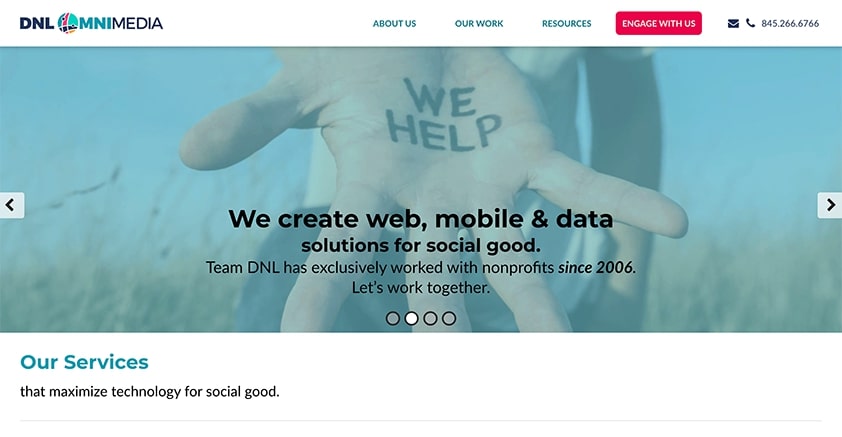
At DNL OmniMedia, our team is well-versed in a variety of nonprofit software solutions and how to help nonprofits make the most of their tools so they can accomplish their missions. We can help your organization build out a digital strategy that helps you accomplish your goals and get closer to accomplishing your mission.
We offer a variety of services related to digital technology, including:
- Software solution implementation and configuration
- Data migration
- Custom integration builds, applications, and product add-ons
- Training and ongoing support for your internal team
- Website design and development
- Marketing strategy design and execution
- Fundraising and development support

The digital tools your nonprofit uses and how you use them play an important role in your organization’s ability to deliver its mission. Use this guide to get started today refining and building out your own digital strategy, and remember to turn to a nonprofit technology expert like Team DNL if you need guidance.
Want to keep reading about nonprofit technology and consulting? Check out these recommended articles:
- Navigating Nonprofit Data Warehouses: A Comprehensive Guide
- Salesforce Nonprofit Cloud: Complete Rundown for Nonprofits
- Nonprofit Consulting Firms: 24 Leaders in Their Spaces
